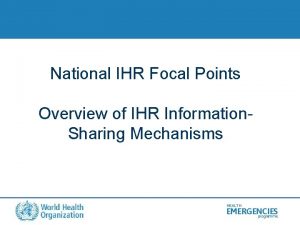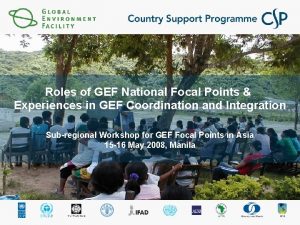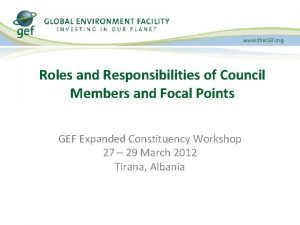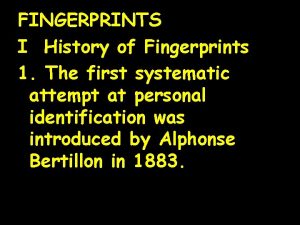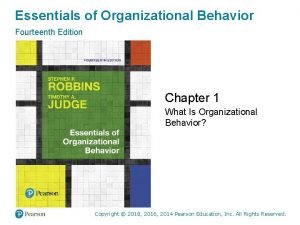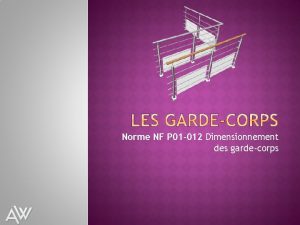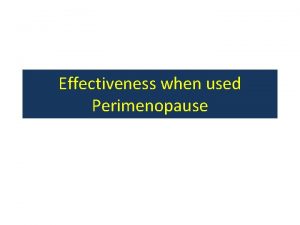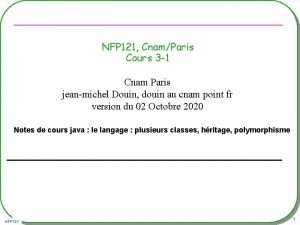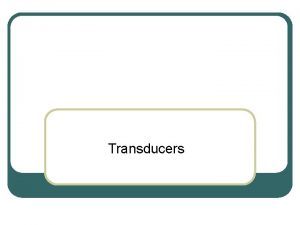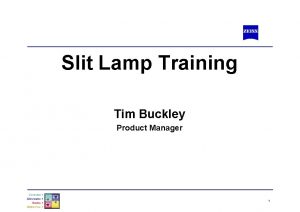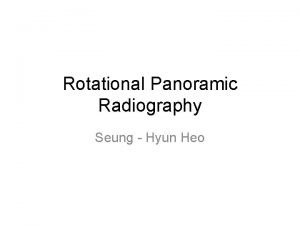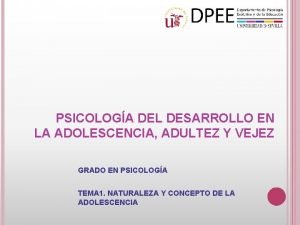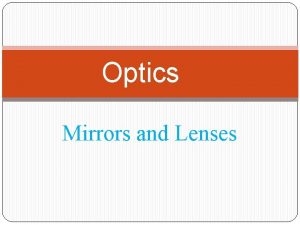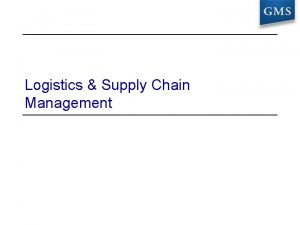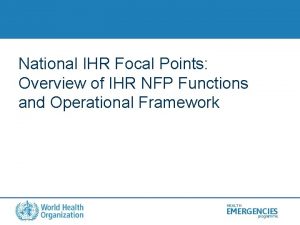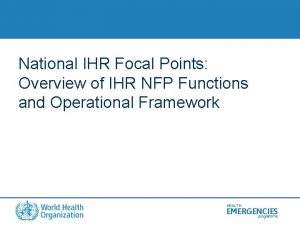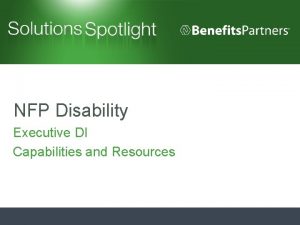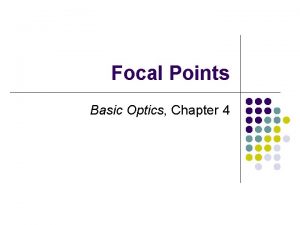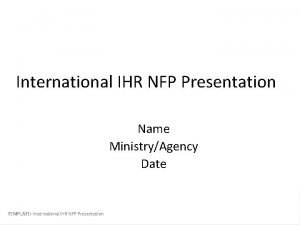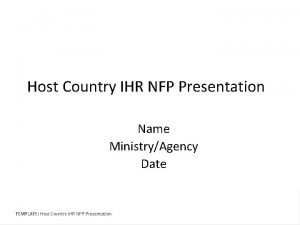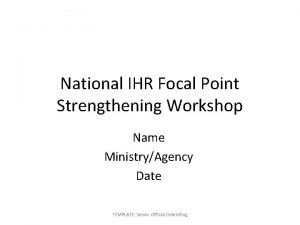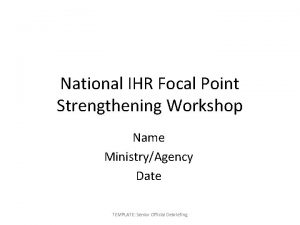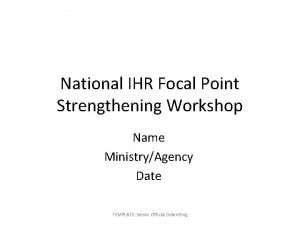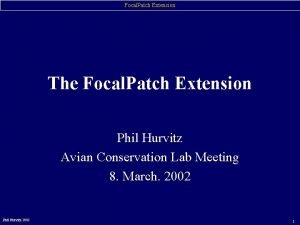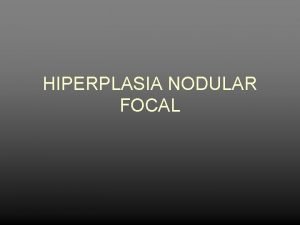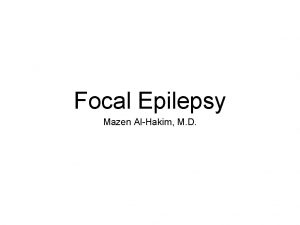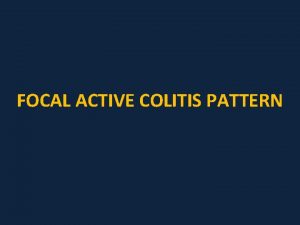National IHR Focal Points Overview of IHR NFP























- Slides: 23

National IHR Focal Points: Overview of IHR NFP Functions and Operational Framework HEALTH EMERGENCIES programme

Outline § Background and overview § IHR NFP operational framework § Mandatory functions § Event notification and information dissemination § Challenges / questions § Summary HEALTH EMERGENCIES programme

Background A highly mobile, interdependent and interconnected world provides opportunities for both the rapid spread of risk and the improvement of global preparedness and response to potential public health emergencies that may have an international impact. HEALTH EMERGENCIES programme

International Health Regulations (IHR) Global health security legal instrument to: § Prevent § Protect against § Provide a public health response …for ALL public health threats A legally-binding global health security framework agreed to by 196 States Parties, including all World Health Organization (WHO) Member States. HEALTH EMERGENCIES programme

Principle of “non-interference” § Aiming to limit international spread of disease and other hazards § While avoiding unnecessary interference with international traffic and trade through: q Early, rapid, and coordinated interventions q Consistent with the level of risk q Evidence-based approach where possible q Closely timed across regions and continents HEALTH EMERGENCIES programme

Core public health capacities § Eight essential elements of a public health system § Intersectoral and multidisciplinary § Foundational for cross-cutting challenges q Zoonotic diseases q Chemical events q Radiological events q Food safety q International (designated) points of entry into the country Legislation and policy Coordination / communication* Surveillance Response Preparedness Risk communications Human Resources *IHR (2005) created a new function – the National IHR Focal Point (NFP) Laboratory HEALTH EMERGENCIES programme

IHR: a global legal instrument What are the International Health Regulations? § A global legal instrument, legally binding States Parties, aimed to help the international community prevent, protect, control and respond to diseases – independent of their origin – that have the potential to cross borders and threaten people worldwide § A collection of domestic and international best practices for public health preparedness and response § An opportunity to strengthen relations among sectors and improve day-to-day public health capacities What are they not? § New vertical program § A public health program § A new science Alert countries to prepare or prevent for HEALTH EMERGENCIES programme

IHR: an umbrella for collective learning Collective learning § To strengthen in the country internal processes whether or not the event is of international importance. § Improve flows and processes of "regular" communication between each institution and its counterpart at the Ministry of Health. § Improve the ability to detect in a timely manner public health events that could have international implications and at the same time improve the response to those events. HEALTH EMERGENCIES programme

Responsible authorities ► Notification ► Reports ► Consultation Verification ◄ National IHR Focal Point (one per State Party) WHO IHR Contact Point (one per region) The National IHR Focal Point is the national centre designated by each State Party which shall be accessible at all times for communications with WHO IHR Contact Points under these Regulations The WHO IHR Contact Point is the unit within WHO which shall be accessible at all times for communications with the National IHR Focal Points HEALTH EMERGENCIES programme

What is a National IHR Focal Point? § One single entry point designated by each country: q Communications with PAHO/WHO and between States Parties. Four mandatory functions § The National IHR Focal Point (NFP) will ideally be an office or center, not a single individual. 1. Notify WHO of a potential public health emergency of international concern (PHEIC) and send urgent IHR related messages. § Annually confirmed. Contact details updated (March 2017). 2. Remain accessible at all times (24/7). § Each NFP must have the authority (legal or administrative framework) to: 3. Disseminate information to relevant national sectors. q q q Communication between IHR NFPs: (e. g. , contract tracing, coordination of control measures/public health response). Work with a variety of sectors within the country to coordinate analysis of national public health events and risk. 4. Consolidate input from relevant national sectors. Report events to the WHO on behalf of the country. HEALTH EMERGENCIES programme

What is an National IHR Focal Point? Responsible for notification to WHO but not necessarily responsible for carrying out the assessment. Event related communication by non IHR NFP - national agencies/institutions to PAHO/WHO § Initial communication, risk assessment, request for information. § Involvement of the respective IHR NFP in the communication. Communication related to events occurring in overseas territories. HEALTH EMERGENCIES programme

IHR operational framework Determine Public Health Emergency of International Concern (PHEIC) Make temporary and standing recommendations Emergency Committee WHO Director-General Review Committee Expert Roster 24/7 accessibility Primary channel for WHO-NFP eventrelated communications Disseminate information within WHO "Activate" the WHO assessment and response system WHO IHR Regional Contact Points Notification Art. 6 -12 Annex 1. A Consultation Report Verification 24/7 accessibility Art. 4 Other competent organizations (IAEA etc. ) Communication with WHO Dissemination of information nationally National IHR Focal Points (NFP) Ministries and sectors concerned Consolidating input nationally Detect Unusual health Assess events Report Respond National surveillance and response systems Incl. Points of Entry Annex 1 Art. 22 Art. 27 HEALTH EMERGENCIES programme

What types of events should be notified under the IHR? § § Four immediately notifiable conditions: q Smallpox q Polio (due to wild-type poliovirus) q Human influenza caused by a new subtype q SARS Four criteria to decide on notification: q Is the public health impact of the event serious? q Is the event unusual or unexpected? q q Is there any significant risk of international spread? Is there any significant risk of international travel or trade restrictions? YES to any two (2) or more criteria indicates that notification of the WHO is required HEALTH EMERGENCIES programme

Notification to WHO HEALTH EMERGENCIES programme

Event management steps HEALTH EMERGENCIES programme

Decision-making for the outcome of the interactions § No action § Public health action q Domestic q International § Information-sharing q Channels of dissemination q Confidentiality q Relevance of information shared and clarity on purposes and expectations q Language Alert countries to prepare or prevent for § Response HEALTH EMERGENCIES programme

Benefits Wildlife Domestic animal cases preven Predicting 90 Rapid response Early detection Human cases prevented 80 Vector Control Operations Number of cases 70 60 50 Control opportunity Animal Amplification 40 30 Animal vaccin 20 10 0 -20 -15 Mitigate -10 -5 0 Days Alert 5 10 15 20 Control 25 30 HEALTH 35 40 EMERGENCIES programme Learn

National public health emergency context § IHR NFP functions as a conduit for information between the national leaders and the global coordinators § Does not replace existing bilateral and multilateral arrangements § IHR mechanisms supplement national-state biosurveillance capacity q Timely notifications of new (potential) events/situations q Process for validating rumors or increasing “transparency” q Network for sharing best practices and situational updates q “Lifeline” for public health disaster resources § At the borders and shared points / ports of entry (POE), community-to-community communication and coordination remains critical HEALTH EMERGENCIES programme 18

Benefits of using the IHR NFP network include: § Efficient manner to communicate public health information with other countries >> easy access to other countries § Effective and reliable system § Readily available list of IHR NFPs (no need to keep up to date contact lists of subject matter experts in various countries) § Opportunity to strengthen information-sharing and collaboration between countries § Helps to meet IHR’s call for the timely and open reporting of public health events for the purpose of global health security HEALTH EMERGENCIES programme 19

Challenges / questions § What is the current scope (i. e. , the purpose, intended action) of using the IHR channels for measles and rubella notifications? § Should this channel be used for international contract tracing (need to balance effort, resources, and overall value)? § What is the minimum information required for public health action to be carried out by other countries? § What are the suggested timelines for reporting and response? § What is the overall perceived/intended public health value of the notification? Do other countries find these communications helpful / beneficial? HEALTH EMERGENCIES programme 20

Summarizing § The role of the IHR NFP is essentially managing/issuing notifications and serving as the point of contact between the State Party and WHO and other IHR NFPs. It has (should have) the authority to receive and send timely information to WHO on behalf of the country. § The IHR NFP does not replace or conflict with any body created at the country level to channel information and response between different actors at the country level to organize the internal response. § An IHR NFP has a core role of international "notification“ to WHO, not the responsibility to organize the “response" to an event (international or otherwise) within the country. HEALTH EMERGENCIES programme 21

Summarizing § Strengthening the role of the IHR NFP (which is an obligation of countries under the IHR) does not necessarily mean changing processes or responsibilities already in place in the country for information-sharing and response to events. § The evaluation of the events using Annex 2 is not actually the IHR NFPs responsibility. The responsibility for assessing events under Annex 2 is actually a requirement of the technical area’s in the ministry and government responsible for that event. § The IHR NFP is involved and can guide or lead such agency or national assessment, but the assessment is a technical activity and should therefore be informed by those units and/or agencies responsible. HEALTH EMERGENCIES programme 22

Pan American Health Organization / World Health Organization. Multilateral IHR NFP Strengthening Workshop Toolkit. June. Washington, DC: PAHO/WHO; 2017 HEALTH EMERGENCIES programme
 National ihr focal point
National ihr focal point Ihr nfp
Ihr nfp Roles of gef
Roles of gef Look for the two innermost diverging ridges
Look for the two innermost diverging ridges Focal point officer
Focal point officer The first systematic attempt at personal identification
The first systematic attempt at personal identification Focal points of ob
Focal points of ob Norme nf p 01-012 garde corps
Norme nf p 01-012 garde corps Edistance
Edistance Nfp private client group
Nfp private client group Marquette nfp perimenopause
Marquette nfp perimenopause Nfp121
Nfp121 Nfp rx solutions
Nfp rx solutions What is nfp
What is nfp Brand positioning bull's eye
Brand positioning bull's eye Point of difference and point of parity
Point of difference and point of parity Overview on the national tuberculosis elimination program
Overview on the national tuberculosis elimination program National unification and the national state
National unification and the national state Fraunhofer zone ultrasound
Fraunhofer zone ultrasound Goldmann lens
Goldmann lens Focal trough in panoramic radiography
Focal trough in panoramic radiography Tendencia secular en la pubertad
Tendencia secular en la pubertad Plano convex lens
Plano convex lens What is a focal firm
What is a focal firm
